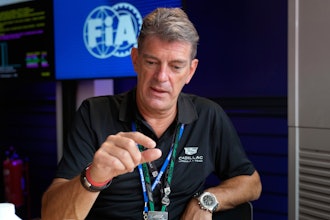Bionic Flying Bats & Rolling Spiders
Festo has upped its bio-mimicry game with a pair of new robots inspired by nature: A Bionic Flying Fox, and BionicWheelBot that can walk and roll like a flic-flac spider. The flying fox is actually just a giant fruit bat with a much less menacing name.
Developers at Festo's Bionic Learning Network were able to replicate the flying fox's movement using on-board electronics and an external motion-tracking system, which also allows the BionicFlyingFox to fly semi-autonomously. It has a wingspan of nearly 7.5 feet (228 cm) and a body that is nearly 3 feet long (87 cm).
The entire robot, with a milled foam body, weighs 1.27 pounds (580 g). The wings are made up of an elastic flying membrane that is wafer-thin and made of two airtight films and a knitted elastane fabric that are welded together at 45,000 points. It has a honeycomb structure that allows the wings to take minor damage and still continue to fly.
The BionicWheelBot mimics the flic-flac spider, a rare creature that lives on the edge of the Sahara Desert. What's crazy is that the spider actually moves faster when rolling than when walking. The robot has a sophisticate mechanical system that can either walk with a tripod gait or tuck its legs and roll across the terrain.
So why does Festo create these feats of bio-engineering? Because they apply it into practical engineering. You don't have to look much further than the company's BionicMotionRobot, a collaborative robot with 12 degrees of freedom that that mimics an elephant's trunk with a gripper inspired by an octopus’s tentacles.
Lockheed to Develop Supersonic X-Plane
Lockheed Martin is trying to take that sonic boom and turn it into what they are calling a gentle supersonic heartbeat.
The company's Skunk Works division recently received a contract from NASA to design, build and flight test the Low-Boom Flight Demonstrator which could make supersonic passenger air travel a reality. The plane will cruise at 55,000 feet, and travel at Mach 1.4 — that's a little over 1,000 mph (1,074 mph) or nearly double the average cruise speed of passenger jets today.
The demonstrator will be a full-scale experimental aircraft also known as an X-plane. Lockheed will build off of its previous design developed under NASA's Quiet Supersonic Technology (QueSST) effort. About a year ago, Lockheed was testing a nine percent scale model of the X-plane in the wind tunnel at NASA's Glenn Research Center in Cleveland.
NASA finished the preliminary design review of its QueSST aircraft design back in June 2017. The X-plane will help NASA establish an acceptable commercial supersonic noise standard to overturn current regulations banning commercial supersonic travel over land.
The prototype will be manufactured at the Lockheed Martin Skunk Works facility in Palmdale, California, with its first flight scheduled for 2021.
Inventor Makes Amphibious Cars Out of Garbage
Last year in Nigeria, a local, self-taught inventor gained global attention with an amphibious car that could also fly. We've seen other vehicles competing to master travel by land, sea, and sky, but what makes the work of Kehinde Durojaiye impressive, is that his vehicles are made from garbage.
Nicknamed 'Kenny Jet', the nearly 50-year-old man has been inventing since he was a kid, spending most of his time at his workshop which is next to a dump site.
You may notice some of the second-hand components, like the computer keyboard, old office chair at the helm, and old bench seats. He's actually made four different prototypes, so he's had to scrounge up a lot of materials, mostly plastic, metal, wood, and polystyrene foam.
According to Kenny Jet, his latest vehicle tops out at 74 mph on the road, and six knots (7 mph) on the sea. He's currently trying to make it fly, but he's married and has four kids, so, wear a helmet, Kenny. After it flies, he's hoping to make it capable subsea travel as well.
Just goes to show that one man's trash is another man's flying amphibious hybrid vehicle.
This is Engineering By Design.




















